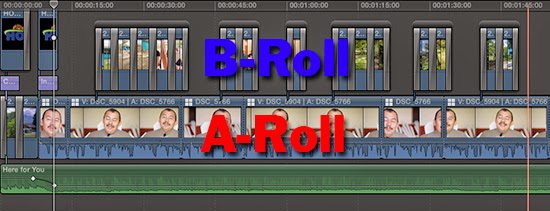Context
Every time I sit down and start editing a package, I come up short with B-Roll. B-Roll is the supplemental or alternative footage intercut with the main shot in an interview or documentary. So, for example, when Larry King interviews Bill Clinton, and the footage appears of Clinton playing the saxophone on Arsenio Hall in 1992, that is a b-roll.
B-Roll goes back to the film days of labeling the 16mm film when editing. Around the 1980s, many editors would mark the decks in the edit suite when the Video was on tapes. For example, the A-Deck would contain the primary interview, and the B-Deck would often include the footage that the editor would use to compliment the interview.
All this is to say the term B-Roll isn’t new.
Today with our digital editing like Final Cut Pro X, I like to think of A-Roll as the main track on the timeline. Below it might be some voice-over or background music. Above the A-Roll is the B-Roll which can be still images or motion footage that I use to compliment the interview.
Remember that A-Roll is the interview, and B-Roll is the images you use to compliment the interview.
General Editing Guidelines
Here are some guides I use when editing my motion package:
- Titles 4 seconds [enough time to read them]
- Still Images 3 – 10 seconds
- Motion Interview 5 – 10 seconds
On the second camera, I use the shotgun Røde Video Pro microphone. I can later choose one or blend the sound if I choose.
The best sound would be a third choice of using a sound guy with a shotgun above the person pointed slightly down 45º at their face in front of the subject.
Since I work alone, I use the second best, the lavalier. Sometimes I blend the lavalier and the shotgun, but most of the time, I prefer the sound from the lavalier for the human voice.
- Try and keep your interview around the present unless you have a lot of B-Roll about the past.
- Have a rough outline of your story before you shoot
- to create a list of B-Rolls shots based on what you think you may need
- Shoot the subject’s environment
- If they have family photos on the walls or tables, get B-Roll. I suggest stills and motion.
- Photograph the home or office from the outside and inside
- Shoot for sound
- If you hear birds in the background during the interview, get some photos of them to drop in to help the audience.
- If people are coming in and out of a screen door on a porch, get some motion of someone coming in and out and use it to help the audience with that sound.
- Intro and endings
- Shoot some scene setters to start your package, end it or use them as bumps between interviews
- Shoot textures
- Textures make great title slides or backgrounds under the lower third titles to help the text be readable.
- Shoot transitions
- Moving the story along often means the subject will talk about childhood and when they went to college, for example. This part of the interview might be a great place for showing your subject: getting in their car; getting out; going through a door; walking in a hallway; walking to you, or walking away
- Watch TV shows to see how they transition from one scene to another, and this can give you more ideas.
- Play the interview right after you do it, listen for all the visual cues you can think of, and write them down. Then go and shoot them.
- Ask the subject for old photos and get copies of them or shoot a copy of them.





